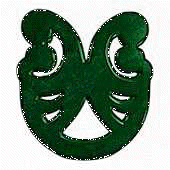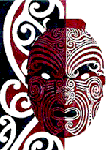|
|
PAUL-HOETAWA FAMILY |
|
|
NEW ZEALAND |
 |
|
 |
![]()
![]()
 |
| Although I have only 1/6 Maori blood, I am proud of the heritage passed down from this side of my family tree. It is a history that is rich in culture, legend, and myth. I record what follows so that the information I have gathered will be of interest to my descendants, and so that it will continue to be passed on. |
 |
|
 |
|
|
History of my Maori Ancestors Migration to New ZealandHawaiki, is the legendary homeland of the Maori peoples of Aotearoa/New Zealand, from whence they migrated to this land about 1000 years ago. Where is Hawaiki? Many have speculated that it lies somewhere in the Pacific, somewhere in Polynesia. Modern scholars tell us that more than 15,000 years ago the Maori lived on the land called China, and that from there they travelled via Taiwan and the Philippines to Indonesia. About 6,000 to 9,000 years ago they moved on through Melanesia and reached Fiji about 3,500 years ago. From there to Samoa and on to the Marquesas 2,500 years ago. Perhaps that was the limit of their eastern migration for it seems that 1,700 years ago they turned South West to Tahiti, thence to the Cook Islands and on to Aotearoa/New Zealand. Archaeological evidence suggests that they first arrived in New Zealand from the Cook Islands in about 800 AD. Several later waves of Maori immigrants appear to have settled in New Zealand over the following 500 years. The last wave of Maori voyagers came from Tahiti about 1350 AD. The Maori immigrants are thought to have mixed with the Moriori, a people of unknown origin, who had settled on the eastern coast of New Zealandís North Island. Maori ancestors gradually settled the land of Aotearoa/New Zealand in many sea-going canoes called 'waka'. My own ancestors came in two waka called Takitimu and Kurahaupo, about 30 generations ago. My tribes which descend from those ancestors are Ngai Tara, Ngati Rangitane, Ngati Kahungunu and Ngai Te Whatuiapiti. Tribal stories tell that at the death of our bodies, our spirits live on and journey back to Hawaiki; to the meeting place of the spirits at Great Hawaiki, Long Hawaiki, Hawaiki far away. Life then is a journey from Hawaiki to Hawaiki, the spiritual homeland of the Maori. And Hawaiki is with us always, carried in our hearts through thousands of generations, and thousands of years of migration; carried also through the lifetime of a single heart wherever it may journey. The Maori, native inhabitants of New Zealand, numbering about 430,000, constitute approximately one-eighth of New Zealandís population. More than 95 percent of Maori live on New Zealandís North Island. Many Maori live in the East Cape area, where they form the majority of the population. Others live in the large cities of New Zealand such as Auckland and Wellington. Most Maori speak the Maori language, a branch of the Austronesian languages, as well as English.
The Maori lived in villages that were generally guarded by a fort. The people were divided into several tribes, or iwi, each made up of descendants of a common ancestor. Groups of tribes were allied in confederations called a waka. Each tribe was made up of a number of hapu, or clans, which in turn were composed of family groups called whanau. Primogeniture, or inheritance by the first born son, was basic to the social system and determined the succession of the highest chief, the ariki. The Maori held many beliefs in common with other Polynesians, including concepts such as tapu (taboo), mana (prestige or honor of a social group or individual), mauri (life force), utu (revenge), and makutu (sorcery). The Maori believed in a number of gods, including Tane-mahuta, lord of the forest, and Tangaroa, a Polynesian ocean god. Tribal dignitaries, such as the higher priests and the chief, also believed in a supreme god, Io, whose existence was not revealed to the community. All Maori believed in a great number of atua, or spirits, who responded to magical spells and punished people for breaking taboos.
The Maori population fell from about 120,000 in 1769 to 42,000 in 1896. In the late 19th century, European settlers spoke of the Maori as a "dying race." In the 20th century the Maori population recovered. Only 11 percent of Maori were city dwellers in 1936, but by the 1980s more than 90 percent of the Maori population lived in urban areas. Whakapapa The term "Te Here Tangata", literally The Rope of Mankind, is also used to describe genealogy. I visualise myself with my hand on this rope which stretches into the past for the fifty or so generations that I can see, back from there to the instant of Creation, and on into the future for at least as long. In this modern world of short term political, social, economic and business perspectives, and instant consumer gratification, Te Here Tangata is a humbling concept. Discovering your Iwi/Tribe Whakapapa includes not just human genealogies, but is also used as a metaphor for the act of Creation and for the evolution of the Universe and all living creatures within it. The diligent researcher will therefore be able to quite easily trace his or her ancestry back through the 800 to 1000 years of human occupation to the first settlers and to their waka (canoe), on from there to the gods, and thence to the very act of creation. The recorded human genealogies reach back for 30 generations and more.
|
This Page was last revised on October 09, 2006
This page was created using MS FrontPage2000, and a bit of HTML. Nothing here is intended to be a breach of Copyright, and the graphics shown were either created by me, or are Copyright of their individual owners.